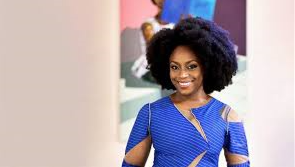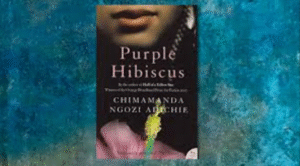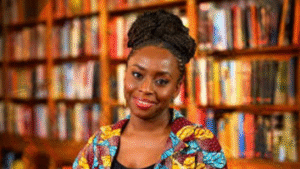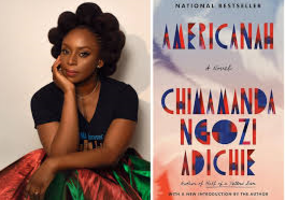Have you ever picked up a book that completely changed how you see the world? For millions of readers across the globe, Chimamanda Ngozi Adichie’s books have done exactly that. Whether you’re a longtime fan or just discovering her work, there’s something magical about the way this Nigerian author weaves stories that feel both deeply personal and universally relevant.
From the purple hibiscus flowers that symbolize freedom in her debut novel to the powerful feminist manifesto that has inspired a generation, Chimamanda Ngozi Adichie’s books offer readers an authentic window into contemporary African life, gender dynamics, identity, and the immigrant experience.
In today’s literary landscape, few voices resonate as powerfully as Adichie’s. Her novels have won prestigious awards, sparked global conversations, and even influenced pop culture through Beyoncé’s sampling of her TED Talk in the song “Flawless.” But what makes her writing so compelling? Why do readers from Lagos to London, from New York to Nairobi, find themselves reflected in her characters? Let’s explore.

What is Chimamanda Adichie Known For?
Chimamanda Ngozi Adichie has built her reputation as one of the most influential contemporary writers of our time. She’s primarily known for her powerful novels that explore themes of identity, colonialism, race, gender, and the African experience both on the continent and in diaspora. Her storytelling combines beautiful prose with unflinching honesty about difficult subjects.
Beyond her novels, Adichie gained international recognition for her essay “We Should All Be Feminists,” which started as a TEDx talk and later became a book. This work introduced feminist ideas to millions of people worldwide in an accessible, conversational way. She’s also celebrated for her short story collections and her ability to capture the nuances of Nigerian culture, particularly Igbo traditions and the impact of the Biafran War on Nigerian society.
Adichie’s work has earned her numerous accolades including the Orange Prize for Fiction, the National Book Critics Circle Award, and a MacArthur Fellowship, often called the “Genius Grant.” She’s regularly featured in discussions about modern literature, feminism, and African storytelling. Her influence extends beyond the literary world into fashion, activism, and cultural commentary.
What Was Chimamanda Ngozi Adichie’s Famous Quote?
Chimamanda Adichie has given us many memorable quotes, but perhaps the most famous comes from her TED Talk “The Danger of a Single Story.” She said: “The single story creates stereotypes, and the problem with stereotypes is not that they are untrue, but that they are incomplete. They make one story become the only story.”
This quote encapsulates one of the central themes in Chimamanda Ngozi Adichie’s books and her entire body of work. She argues that when we only hear one narrative about a person, place, or culture, we risk misunderstanding the full complexity of that reality. This idea has resonated with educators, readers, and thinkers worldwide who recognize how single narratives limit our understanding of diverse experiences.
Another widely quoted line from her feminist essay states: “Culture does not make people. People make culture. If it is true that the full humanity of women is not our culture, then we can and must make it our culture.” This powerful statement challenges the use of tradition as an excuse for gender inequality and has become a rallying cry for feminist movements globally.

What is Adichie’s Main Idea?
At the heart of Adichie’s work lies a commitment to telling complete, multifaceted stories about African people, particularly Nigerian experiences. Her main idea revolves around the concept that every person and culture contains multitudes, and no single narrative can capture the full truth of human experience.
Adichie consistently challenges Western stereotypes about Africa while simultaneously refusing to romanticize African culture. She presents characters who are fully human with contradictions, flaws, dreams, and complexities. Through her writing, she demonstrates that African stories deserve to be told on their own terms, not as responses to or variations of Western narratives.
Another central theme in Chimamanda Ngozi Adichie’s books is the exploration of identity formation. Her characters often navigate multiple identities related to nationality, gender, race, class, and personal history. She shows how these identities can conflict, complement, or complicate each other, particularly for immigrants and people living between cultures.
Feminism also forms a core pillar of her philosophy. Adichie advocates for a feminism that acknowledges cultural specificity while maintaining universal principles of equality and human dignity. She argues that gender equality benefits everyone, not just women, and that we must raise both our sons and daughters differently to achieve true equality.
What is Chimamanda Ngozi Adichie’s Most Famous Book?
While all of Chimamanda Ngozi Adichie’s books have received critical acclaim, “Americanah” stands out as her most commercially successful and widely discussed novel. Published in 2013, this sweeping story follows Ifemelu, a young Nigerian woman who moves to America for university and becomes a blogger writing about race in America.
“Americanah” resonated with readers because it tackled race, immigration, and identity with brutal honesty and humor. The novel explores what it means to be Black in America versus being African in America, a distinction many immigrants recognize but rarely see articulated in mainstream literature. The book spent weeks on the New York Times bestseller list and won the National Book Critics Circle Award for Fiction.
However, “Half of a Yellow Sun” runs a close second in terms of fame and impact. This novel about the Biafran War won the Orange Prize for Fiction and has been translated into numerous languages. Many readers and critics consider it her masterpiece because of its ambitious scope, historical significance, and emotional depth.
Her essay “We Should All Be Feminists” might actually be her most influential work in terms of cultural impact, even though it’s not a traditional book. This short manifesto has been distributed to every sixteen-year-old in Sweden and has introduced countless people to feminist ideas in an approachable way.
What is Chimamanda Adichie’s View on Feminism?
Adichie’s feminist philosophy centers on the belief that feminism is simply the conviction that men and women deserve equal rights and opportunities. She presents feminism not as a complex ideology requiring years of academic study, but as a common-sense approach to human dignity and fairness.
Her feminism is culturally grounded in her Nigerian Igbo heritage while maintaining universal principles. She rejects the notion that feminism is a Western concept imposed on African cultures, pointing out that gender inequality is not inherently African and that many African societies had more egalitarian structures before colonialism.
In her writings and talks, Adichie emphasizes that feminism should concern men just as much as women. She argues that patriarchy harms everyone by forcing men into restrictive masculine roles and denying women full personhood. She advocates for raising children without the limiting gender expectations that tell boys they cannot be vulnerable and girls they cannot be ambitious.
Adichie also acknowledges the intersection of feminism with other aspects of identity. She discusses how race, class, and nationality complicate feminist conversations and insists that feminism must address these intersections to be truly inclusive. Her approach to feminism in Chimamanda Ngozi Adichie’s books and essays remains accessible, practical, and rooted in everyday experiences rather than abstract theory.
Is Chimamanda Ngozi Adichie Igbo or Yoruba?
Chimamanda Ngozi Adichie is Igbo, one of the three major ethnic groups in Nigeria. She was born in Enugu, in southeastern Nigeria, which is the heartland of Igbo culture. Her full name reflects her Igbo heritage, with “Ngozi” meaning “blessing” in the Igbo language.
Her Igbo identity features prominently in Chimamanda Ngozi Adichie’s books, particularly in “Half of a Yellow Sun,” which tells the story of the Biafran War. This civil war from 1967 to 1970 was fought primarily by the Igbo people seeking independence from Nigeria after experiencing persecution and violence. The war remains a defining event in Igbo collective memory, and Adichie’s novel brought this history to international attention.
Growing up, Adichie was surrounded by Igbo culture and traditions. Her family’s ancestral home is in Abba, a town in Anambra State. However, her work also demonstrates a deep understanding of Nigeria’s multicultural complexity, and she writes about characters from various ethnic backgrounds with equal nuance and respect.
Her Igbo heritage influences not just her subject matter but also her narrative style. The oral storytelling traditions of Igbo culture, with their emphasis on proverbs, community wisdom, and layered meanings, can be seen throughout her novels and essays.
Does Chimamanda Adichie Have a Child?
Yes, Chimamanda Adichie has a daughter. She gave birth to her child in 2016, though she keeps her family life relatively private and doesn’t frequently discuss her daughter in public forums. This privacy reflects her belief that public figures should be able to maintain boundaries between their professional work and personal lives.
Adichie has occasionally spoken about how motherhood has influenced her perspective, particularly regarding gender socialization and the messages we send to children. Her experiences raising a daughter in the modern world have informed her thinking about feminism and education, themes that appear in her book “Dear Ijeawele, or A Feminist Manifesto in Fifteen Suggestions.”
This book takes the form of a letter to a friend asking for advice on raising a feminist daughter. Drawing from her own experiences and observations, Adichie offers practical guidance on topics like encouraging confidence, teaching about gender stereotypes, and modeling equality in relationships. The personal nature of this advice suggests it comes from her own journey as a mother.
While she protects her daughter’s privacy, Adichie has mentioned that becoming a parent deepened her commitment to creating a more equitable world. The stakes of feminist work feel more urgent when you’re raising a child who will inherit the society we create today.
What Was Chimamanda’s First Book?
“Purple Hibiscus” was Chimamanda Adichie’s first published novel, released in 2003 when she was just 26 years old. This debut novel tells the story of Kambili, a fifteen-year-old girl growing up in Nigeria under the oppressive rule of her deeply religious father, Eugene.
The novel explores themes of religious fanaticism, domestic violence, political unrest, and coming of age. Set against the backdrop of a military coup in Nigeria, “Purple Hibiscus” examines how personal and political tyranny intersect and how silence can be both a survival strategy and a form of complicity.
For a first novel, “Purple Hibiscus” received remarkable critical acclaim. It was shortlisted for the Orange Prize for Fiction and won the Commonwealth Writers’ Prize for Best First Book. Critics praised Adichie’s mature voice, her sensitive handling of difficult subjects, and her ability to create memorable characters.
The purple hibiscus flower itself serves as a powerful symbol in the novel, representing freedom, defiance, and the possibility of new beginnings. Kambili’s aunt Ifeoma grows these rare flowers, and they come to symbolize an alternative way of living that is less rigid and more joyful than Kambili’s home environment.
This debut established many of the themes and stylistic choices that would characterize Chimamanda Ngozi Adichie’s books throughout her career including her focus on female protagonists, her exploration of Nigerian politics and culture, and her beautiful, precise prose.
Which Story Was Written First?
Before “Purple Hibiscus,” Adichie wrote several short stories during her time at university. Her story “For Love of Biafra” was published in 1998, making it likely her first published work. This early story already showed her interest in the Biafran War, a subject she would explore more fully in “Half of a Yellow Sun.”
During her undergraduate years at Eastern Connecticut State University, Adichie studied communication and political science while writing fiction. She later moved to Johns Hopkins University for a master’s degree in African Studies, and then to Yale for an MA in creative writing. Throughout this academic journey, she continued developing her craft through short stories.
Many of these early stories were later collected in “The Thing Around Your Neck,” published in 2009. This collection includes stories written over several years, some dating back to her time as a student. The stories explore themes of immigration, cultural displacement, and the Nigerian immigrant experience in America.
While “Purple Hibiscus” was her first novel, Adichie’s short story writing helped her develop the voice and techniques that made her debut so successful. The economy of language required for short fiction trained her to write with precision, while the longer form of the novel allowed her to develop the complex, layered narratives for which Chimamanda Ngozi Adichie’s books are now famous.

How Many Books Did Chimamanda Ngozi Adichie Write?
Chimamanda Ngozi Adichie has published multiple books across various genres:
Novels:
- Purple Hibiscus (2003)
- Half of a Yellow Sun (2006)
- Americanah (2013)
Short Story Collection:
- The Thing Around Your Neck (2009)
Non-fiction Essays:
- We Should All Be Feminists (2014)
- Dear Ijeawele, or A Feminist Manifesto in Fifteen Suggestions (2017)
- Notes on Grief (2021)
This brings her total to seven major published books, though she has also written numerous essays, articles, and given influential talks that have been published in various formats. Each work has contributed to her reputation as one of the most important voices in contemporary literature.
Her three novels represent substantial literary achievements, each taking years to research and write. “Half of a Yellow Sun” required extensive research into the Biafran War, including interviews with survivors and study of historical documents. “Americanah” drew from her own experiences living in America and observations about race relations.
The shorter non-fiction works have arguably reached even wider audiences than her novels. “We Should All Be Feminists” has been translated into more than thirty languages and sparked conversations about gender equality worldwide. “Notes on Grief,” written after the death of her father, offers a moving meditation on loss and mourning.
Fans eagerly await each new release from Adichie, knowing that whether it’s fiction or non-fiction, her work will offer fresh insights, beautiful writing, and honest reflections on the human condition.
Why Did Adichie Write Purple Hibiscus?
Adichie wrote “Purple Hibiscus” to explore the intersections of personal and political oppression in Nigeria. She wanted to tell a story about how authoritarian regimes affect individual families and how domestic tyranny mirrors political tyranny. The novel emerged from her observations of Nigerian society and her desire to examine the complexities of religious faith, family loyalty, and the cost of silence.
The character of Eugene, Kambili’s father, represents a particular type of post-colonial Nigerian elite: educated, successful, and deeply committed to his Catholic faith, yet disconnected from traditional Igbo culture. Through Eugene, Adichie explores the psychological legacy of colonialism and how colonial religion and education can create internal conflicts within individuals and families.
Adichie has mentioned in interviews that she wanted to write about domestic violence in a way that acknowledged the humanity of both the abuser and the abused. Eugene is not a simple villain; he’s a pillar of his community, generous to the poor, and brave in opposing the military government. This complexity makes the novel more powerful because it reflects the reality that abusers are often respected public figures.
The coming-of-age aspect of “Purple Hibiscus” allowed Adichie to explore how young people develop their own identities separate from their parents’ expectations. Kambili’s journey from silence to voice mirrors Nigeria’s own struggle for freedom of expression under military rule.
Writing this novel as her debut, Adichie established herself as a writer willing to tackle difficult subjects with nuance and compassion. The success of “Purple Hibiscus” gave her the platform to continue exploring themes of identity, power, and resistance in subsequent works.
The Literary Style and Themes in Chimamanda Ngozi Adichie’s Books
One of the distinguishing features of Chimamanda Ngozi Adichie’s books is her accessible yet literary prose style. She writes with clarity and precision, avoiding unnecessarily complex language while still creating beautiful, memorable sentences. This approach makes her work appeal to both casual readers and literary critics.
Her novels typically feature strong female protagonists who are intelligent, complex, and flawed. These women navigate difficult circumstances while maintaining their agency and dignity. From Kambili in “Purple Hibiscus” to Ifemelu in “Americanah,” Adichie’s heroines feel like real people rather than idealized characters.
Historical and political context plays a crucial role in her storytelling. She embeds personal stories within larger historical events, showing how politics affects individual lives. The Biafran War frames “Half of a Yellow Sun,” military dictatorship shadows “Purple Hibiscus,” and American racial politics permeates “Americanah.”
Adichie also excels at depicting relationships with honesty and depth. Whether writing about romantic love, family bonds, or friendships, she captures the ways people hurt, heal, and connect with each other. Her characters feel authentic because they behave in contradictory, human ways.
The immigrant experience appears frequently in Chimamanda Ngozi Adichie’s books, particularly the psychological impact of moving between cultures. She writes about the small moments of cultural dislocation, the strategic code-switching, and the complex relationship immigrants have with both their homeland and their adopted country.
The Global Impact of Chimamanda Ngozi Adichie’s Books
Chimamanda Ngozi Adichie’s books have achieved something remarkable: they’ve brought African stories to global audiences while maintaining authenticity and refusing to explain or simplify African culture for Western readers. This approach has influenced countless writers who now feel empowered to tell their own stories without apology.
Her work appears on reading lists at universities worldwide, introducing students to contemporary African literature. Educators appreciate how her novels provide entry points for discussing difficult topics like colonialism, race, gender, and immigration. The accessibility of her writing makes these complex subjects approachable for readers at various levels.
“Americanah” in particular has become essential reading for understanding modern discussions about race and identity. The novel’s honest exploration of how Black immigrants experience America differently from African Americans has sparked important conversations about racial dynamics and the Black diaspora.
The feminist essays have had perhaps the broadest cultural impact. “We Should All Be Feminists” introduced feminist principles to people who might never have picked up a feminist text otherwise. Its conversational tone and personal anecdotes make gender equality feel like common sense rather than radical ideology.
Adichie’s influence extends into popular culture through the Beyoncé connection and her frequent appearances at major conferences and events. She’s become a public intellectual whose opinions on various subjects attract media attention. This visibility helps keep African perspectives in global conversations.
Where to Start with Chimamanda Ngozi Adichie’s Books
For readers new to Adichie’s work, “Purple Hibiscus” makes an excellent starting point. As her first novel, it introduces her style and themes in a more compact, focused narrative. The coming-of-age story provides an emotional anchor while exploring deeper themes of freedom, religion, and family.
Those interested in historical fiction should begin with “Half of a Yellow Sun.” This novel offers an immersive experience in a crucial period of Nigerian history while delivering a powerful story about love, war, and survival. However, it’s the most emotionally demanding of her novels, so readers should prepare for some difficult scenes.
“Americanah” works well for readers interested in contemporary issues of race, immigration, and identity. Its humor and romance make it highly readable despite its length and serious themes. The blog posts interspersed throughout the narrative add variety to the storytelling format.
For those wanting a quick introduction, “We Should All Be Feminists” provides a perfect entry point. At fewer than fifty pages, this essay distills Adichie’s ideas about gender equality into an accessible, engaging read that can be finished in one sitting.
“The Thing Around Your Neck” offers variety through its short story format. Readers can sample different aspects of Adichie’s writing and choose which themes resonate most with them. The stories range from humorous to heartbreaking, all showcasing her narrative skill.
Frequently Asked Questions About Chimamanda Ngozi Adichie
What awards has Chimamanda Ngozi Adichie won?
Chimamanda Adichie has received numerous prestigious awards throughout her career. She won the Orange Prize for Fiction in 2007 for “Half of a Yellow Sun,” which is one of the most significant awards in contemporary literature. The National Book Critics Circle Award came in 2013 for “Americanah.” She received a MacArthur Fellowship, commonly known as the “Genius Grant,” in 2008, which recognizes individuals who show exceptional creativity and potential.
Her debut novel “Purple Hibiscus” won the Commonwealth Writers’ Prize for Best First Book. She’s also been honored with the Anisfield-Wolf Book Award, numerous honorary degrees from universities worldwide, and was named one of Time Magazine’s 100 Most Influential People. These awards reflect the literary excellence and cultural impact of Chimamanda Ngozi Adichie’s books across different genres and themes.
Where does Chimamanda Ngozi Adichie live now?
Chimamanda Adichie splits her time between Nigeria and the United States, maintaining strong connections to both countries. She has a home in Lagos, Nigeria, where she spends significant portions of the year, and also resides in the United States where she has lived for many years.
This transnational lifestyle informs much of her writing about immigration, identity, and the experience of moving between cultures. She has spoken in interviews about the importance of maintaining her connection to Nigeria and not becoming disconnected from the society she writes about.
Her dual residence allows her to observe both American and Nigerian cultures from both insider and outsider perspectives, which enriches the authenticity and insight in her novels. This lived experience of cultural multiplicity appears throughout Chimamanda Ngozi Adichie’s books, particularly in “Americanah,” where the protagonist also navigates life between Nigeria and America.
Has Chimamanda Ngozi Adichie written any books since Americanah?
Since publishing “Americanah” in 2013, Adichie has focused primarily on non-fiction rather than novels. She published “We Should All Be Feminists” in 2014, which expanded her influential TED Talk into book form. In 2017, she released “Dear Ijeawele, or A Feminist Manifesto in Fifteen Suggestions,” offering practical advice on raising children with feminist values.
Her most recent book is “Notes on Grief,” published in 2021, a deeply personal meditation on losing her father during the COVID-19 pandemic. While fans eagerly await her next novel, Adichie has mentioned in interviews that she writes novels slowly and deliberately, taking time to develop ideas fully. She remains active in writing essays, delivering lectures, and contributing to literary and cultural conversations globally.
The gap between novels is not unusual for literary fiction writers who prioritize quality over quantity, and the non-fiction works have allowed her to address urgent contemporary issues while developing her next major work of fiction.
What is Chimamanda Adichie’s writing process?
Adichie approaches writing with discipline and dedication, treating it as serious work rather than waiting for inspiration. She writes daily when working on a project, preferring morning hours when her mind is fresh. For novels, she conducts extensive research before and during the writing process, particularly for historical fiction like “Half of a Yellow Sun,” which required studying the Biafran War through documents, photographs, and interviews with people who lived through it.
She has mentioned in interviews that she writes multiple drafts, revising extensively to achieve the precise language and pacing she wants. Unlike some writers who outline everything in advance, Adichie allows her characters and stories to evolve organically, though she has a general sense of direction. She reads widely across genres and cultures, believing that good writing requires exposure to diverse voices and styles.
Her process also involves taking breaks between projects to let ideas develop naturally rather than forcing creativity. This thoughtful, patient approach to writing contributes to the quality and depth found in Chimamanda Ngozi Adichie’s books.
What themes appear most frequently in Chimamanda Ngozi Adichie’s books?
Several interconnected themes recur throughout Adichie’s body of work, creating a cohesive literary vision. Identity formation stands central, particularly how individuals develop sense of self amid competing cultural, national, and personal influences. Immigration and cultural displacement appear frequently, exploring psychological costs and opportunities of moving between worlds.
Gender and feminism pervade her work, examining how patriarchy affects both women and men while advocating for equality. The legacy of colonialism influences many narratives, showing how colonial history continues shaping contemporary African societies. Family relationships receive deep attention, especially complex parent-child dynamics and ways family members both support and constrain each other. Political oppression and corruption form backdrops for personal stories, demonstrating how politics impacts individual lives.
Race and racial identity, particularly in American context, feature prominently in her writing about immigrant experiences. Love in its various forms—romantic, familial, platonic—appears as both transformative force and source of pain. These themes interweave throughout Chimamanda Ngozi Adichie’s books, creating rich, layered narratives that resonate with diverse readers worldwide.
Conclusion: The Enduring Relevance of Chimamanda Ngozi Adichie’s Books
As we’ve explored throughout this comprehensive guide, Chimamanda Ngozi Adichie’s books represent more than just beautifully crafted novels and essays. They offer windows into experiences that too often remain invisible in mainstream literature, perspectives that challenge readers to question their assumptions, and stories that remind us of our shared humanity despite cultural differences.
From the oppressive household in “Purple Hibiscus” to the sweeping historical canvas of “Half of a Yellow Sun,” from the incisive cultural commentary in “Americanah” to the accessible feminist philosophy in her essays, Adichie has created a body of work that will continue influencing readers and writers for generations. Her commitment to telling complete, nuanced stories about African people has expanded what global audiences understand about contemporary African life.
What makes Chimamanda Ngozi Adichie’s books particularly valuable in today’s world is their timeless quality. For anyone seeking literature that combines artistic excellence with meaningful engagement with the world, Chimamanda Ngozi Adichie’s books offer an essential reading experience. They remind us why storytelling matters, why diverse voices enrich our understanding, and why the best literature both reflects our world and helps us imagine how it might be transformed.



